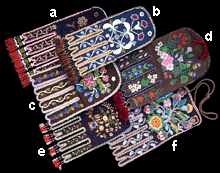
Métis Octopus-Type Pouches
 |
Woollen cloth decorated with silk ribbon, woollen tassels, silk thread, and glass beads; cotton cloth lining Métis octopus pouches -- so called for the four double tabs at the bottom -- were used for carrying pipe, tobacco, and flint-and-steel. Floral designs on articles made by the Indians of the northern forests were once thought to be traditional native motifs. Yet, such patterns are seldom seen on items made before 1800, and were never present in prehistoric native art expressions. The designs on these mid-nineteenth century Métis pouches clearly represent European flowers in compositions that are reminiscent of colonial folk art. This influence is not surprising when we consider that Ursuline nuns in Quebec in the mid-1600s had started mission schools in which they instructed Native girls in the art of embroidery. Truly floral art, however, had its genesis in the Great Lakes region in the late eighteenth century. There, Métis women living at missions and fur trade posts integrated realistic floral designs into their pictorial vocabulary. By the time the Métis had settled on the Red River, their floral artistry was so distinctive that they came to be called the Flower Beadwork People by the Indians of the region. Gradually, through trade and intermarriage with the Métis, Native peoples began to borrow their brilliant floral motifs, and the style spread throughout northwestern Canada. |
